Improving the Electrochemical Glycerol-to-Glycerate Conversion at Pd Sites via the Interfacial Hydroxyl Immigrated from Ni Sites
Abstract
:1. Introduction
2. Results and Discussion
2.1. Structure of Catalysts
2.2. GOR Activity and Selectivity at Pd/NF
2.3. GOR Stability at Pd/NF
2.4. The Promoting Effect of Pd/NF on GOR
3. Experimental Section
3.1. Chemicals and Materials
3.2. Synthesis of Catalysts
3.2.1. Synthesis of Pd/NF Catalysts
3.2.2. Synthesis of Pd/C and Pd Black Catalysts
3.3. Characterization
3.4. Electrochemical Measurements
3.5. Product Analysis
3.6. In Situ Electrochemical Infrared Spectral Measurements
4. Conclusions
Supplementary Materials
Author Contributions
Funding
Institutional Review Board Statement
Informed Consent Statement
Data Availability Statement
Conflicts of Interest
References
- Attarbachi, T.; Kingsley, M.D.; Spallina, V. New Trends on Crude Glycerol Purification: A Review. Fuel 2023, 340, 127485. [Google Scholar] [CrossRef]
- Rahim, S.A.N.M.; Lee, C.S.; Abnisa, F.; Aroua, M.K.; Daud, W.A.W.; Cognet, P.; Pérès, Y. A Review of Recent Developments on Kinetics Parameters for Glycerol Electrochemical Conversion—A By-Product of Biodiesel. Sci. Total Environ. 2020, 705, 135137. [Google Scholar] [CrossRef]
- Liu, C.J.; Wang, H.M.; Karim, A.M.; Sun, J.M.; Wang, Y. Catalytic Fast Pyrolysis of Lignocellulosic Biomass. Chem. Soc. Rev. 2014, 43, 7594–7623. [Google Scholar] [CrossRef]
- Verma, S.; Lu, S.; Kenis, P.J.A. Co-Electrolysis of CO2 and Glycerol as a Pathway to Carbon Chemicals with Improved Technoeconomics due to Low Electricity Consumption. Nat. Energy 2019, 4, 466–474. [Google Scholar] [CrossRef]
- Akhade, S.A.; Singh, N.; Gutiérrez, O.Y.; Lopez-Ruiz, J.; Wang, H.; Holladay, J.D.; Liu, Y.; Karkamkar, A.; Weber, R.S.; Padmaperuma, A.B.; et al. Electrocatalytic Hydrogenation of Biomass-Derived Organics: A Review. Chem. Rev. 2020, 120, 11370–11419. [Google Scholar] [CrossRef]
- Bricotte, L.; Chougrani, K.; Alard, V.; Ladmiral, V.; Caillol, S. Dihydroxyacetone: A User Guide for a Challenging Bio-Based Synthon. Molecules 2023, 28, 2724. [Google Scholar] [CrossRef]
- Yu, H.-Z.; Hu, M.-Y.; Chen, C.; Hu, C.-J.; Li, Q.-H.; Hu, F.; Peng, S.-J.; Ma, J. Ambient γ-Rays-Mediated Noble-Metal Deposition on Defect-Rich Manganese Oxide for Glycerol-Assisted H2 Evolution at Industrial-Level Current Density. Angew. Chem. Int. Ed. 2023, 62, e202314569. [Google Scholar] [CrossRef] [PubMed]
- Wang, Y.; Zhang, M.; Liu, Y.; Zheng, Z.; Liu, B.; Chen, M.; Guan, G.; Yan, K. Recent Advances on Transition-Metal-Based Layered Double Hydroxides Nanosheets for Electrocatalytic Energy Conversion. Adv. Sci. 2023, 10, 2207519. [Google Scholar] [CrossRef] [PubMed]
- Chen, Z.; Liu, C.; Zhao, X.; Yan, H.; Li, J.; Lyu, P.; Du, Y.; Xi, S.; Chi, K.; Chi, X.; et al. Promoted Glycerol Oxidation Reaction in an Interface-Confined Hierarchically Structured Catalyst. Adv. Mater. 2019, 31, 1804763. [Google Scholar] [CrossRef]
- Kwon, Y.; Schouten, K.J.P.; Koper, M.T.M. Mechanism of the Catalytic Oxidation of Glycerol on Polycrystalline Gold and Platinum Electrodes. ChemCatChem 2011, 3, 1176–1185. [Google Scholar] [CrossRef]
- Li, Y.; Wei, X.; Pan, R.; Wang, Y.; Luo, J.-J.; Li, L.-X.; Chen, L.-S.; Shi, J.-L. PtAu Alloying-Modulated Hydroxyl and Substrate Adsorption for Glycerol Electrooxidation to C3 Products. Energy Environ. Sci. 2024, 17, 4205–4215. [Google Scholar] [CrossRef]
- Garcia, A.C.; Kolb, M.J.; van Nierop y Sanchez, C.; Vos, J.; Birdja, Y.Y.; Kwon, Y.; Tremiliosi-Filho, G.; Koper, M.T.M. Strong Impact of Platinum Surface Structure on Primary and Secondary Alcohol Oxidation during Electro-Oxidation of Glycerol. ACS Catal. 2016, 6, 4491–4500. [Google Scholar] [CrossRef]
- Hu, X.-Y.; Lu, J.; Liu, Y.; Chen, L.; Zhang, X.-W.; Wang, H.-T. Sustainable Catalytic Oxidation of Glycerol: A Review. Environ. Chem. Lett. 2023, 21, 2825–2861. [Google Scholar] [CrossRef]
- Luo, H.; Yukuhiro, V.Y.; Fernández, P.S.; Feng, J.; Thompson, P.; Rao, R.R.; Cai, R.; Favero, S.; Haigh, S.J.; Durrant, J.R.; et al. Role of Ni in PtNi Bimetallic Electrocatalysts for Hydrogen and Value-Added Chemicals Coproduction via Glycerol Electrooxidation. ACS Catal. 2022, 12, 14492–14506. [Google Scholar] [CrossRef]
- Lima, C.C.; Rodrigues, M.V.F.; Neto, A.F.M.; Zanata, C.R.; Pires, C.T.G.V.M.T.; Costa, L.S.; Solla-Gullón, J.; Fernández, P.S. Highly Active Ag/C Nanoparticles Containing Ultra-Low Quantities of Sub-Surface Pt for the Electrooxidation of Glycerol in Alkaline Media. Appl. Catal. B Environ. 2020, 279, 119369. [Google Scholar] [CrossRef]
- Li, J.-F.; Jiang, K.-H.; Bai, S.-H.; Guan, C.-H.; Wei, H.; Chu, H.-B. High Productivity of Tartronate from Electrocatalytic Oxidation of High Concentration Glycerol through Facilitating the Intermediate Conversion. Appl. Catal. B Environ. 2022, 317, 121784. [Google Scholar] [CrossRef]
- Meng, Q.-C.; Jin, L.-B.; Ma, M.-Z.; Gao, X.-Q.; Chen, A.-B.; Zhou, D.-J.; Sun, X.-M. Highly Dispersed Pt Nanoparticles Root in Single-Atom Fe Sites in LDHs toward Efficient Methanol Oxidation. J. Electrochem. 2023, 29, 45–53. [Google Scholar]
- Shi, K.; Si, D.; Teng, X.; Chen, L.-S.; Shi, J.-L. Pd/NiMoO4/NF Electrocatalysts for the Efficient and Ultra-Stable Synthesis and Electrolyte-Assisted Extraction of Glycolate. Nat. Commun. 2024, 15, 2899. [Google Scholar] [CrossRef]
- Huang, X.; Feng, J.; Hu, S.-N.; Xu, B.-Y.; Hao, M.-S.; Liu, X.-Z.; Wen, Y.; Su, D.; Ji, Y.-J.; Li, Y.-Y.; et al. Regioselective Epitaxial Growth of Metallic Heterostructures. Nat. Nanotechnol. 2024, 2725. [Google Scholar] [CrossRef] [PubMed]
- Zhang, X.-T.; Hui, L.; Yan, D.-X.; Li, J.-Z.; Chen, X.; Wu, H.; Li, Y.-L. Defect Rich Structure Activated 3D Palladium Catalyst for Methanol Oxidation Reaction. Angew. Chem. Int. Ed. 2023, 62, e202308968. [Google Scholar] [CrossRef] [PubMed]
- Wu, W.-X.; Wang, Y. Electrochemical Oxidation of Ethylene on Palladium Electrode. J. Electrochem. 2023, 29, 39–46. [Google Scholar]
- Zhang, J.-M.; Zhang, X.-J.; Chen, Y.; Fan, Y.-J.; Fan, Y.-J.; Jia, J.-F. Deep Euteceic Solvents-Assisted Synthesis of Novel Network Nanostructures for Accelerating Formic Acid Electrooxidation. J. Electrochem. 2023, 29, 35–44. [Google Scholar]
- Zhou, X.-C.; Ma, Y.-B.; Ge, Y.; Zhu, S.-Q.; Cui, Y.; Chen, B.; Liao, L.; Yun, Q.; He, Z.; Long, H.; et al. Preparation of Au@Pd Core–Shell Nanorods with fcc-2H-fcc Heterophase for Highly Efficient Electrocatalytic Alcohol Oxidation. J. Am. Chem. Soc. 2022, 144, 547–555. [Google Scholar] [CrossRef] [PubMed]
- Huang, B.; Ge, Y.; Zhang, A.; Zhu, S.; Chen, B.; Li, G.; Yun, Q.; Huang, Z.; Shi, Z.; Zhou, X.; et al. Seeded Synthesis of Hollow PdSn Intermetallic Nanomaterials for Highly Efficient Electrocatalytic Glycerol Oxidation. Adv. Mater. 2023, 35, 2302233. [Google Scholar] [CrossRef]
- Holade, Y.; Morais, C.; Servat, K.; Napporn, T.W.; Kokoh, K.B. Toward the Electrochemical Valorization of Glycerol: Fourier Transform Infrared Spectroscopic and Chromatographic Studies. ACS Catal. 2013, 3, 2403–2411. [Google Scholar] [CrossRef]
- He, Z.-Y.; Hwang, J.; Gong, Z.-H.; Zhou, M.-Z.; Zhang, N.; Kang, X.-W.; Han, J.W.; Chen, Y. Promoting Biomass Electrooxidation via Modulating Proton and Oxygen Anion Deintercalation in Hydroxide. Nat. Commun. 2022, 13, 3777. [Google Scholar] [CrossRef] [PubMed]
- Li, T.; Harrington, D.A. An Overview of Glycerol Electrooxidation Mechanisms on Pt, Pd and Au. ChemSusChem 2021, 14, 1472–1495. [Google Scholar] [CrossRef]
- White, J.; Terekhina, I.; Campos dos Santos, E.; Martín-Yerga, D.; Pettersson, L.G.M.; Johnsson, M.; Cornell, A. Synergistic Bimetallic PdNi Nanoparticles: Enhancing Glycerol Electrooxidation While Preserving C3 Product Selectivity. ACS Appl. Energy Mater. 2024, 7, 1802–1813. [Google Scholar] [CrossRef]
- Zalineeva, A.; Serov, A.; Padilla, M.; Martinez, U.; Artyushkova, K.; Baranton, S.; Coutanceau, C.; Atanassov, P.B. Glycerol Electrooxidation on Self-Supported Pd1Snx Nanoparticules. Appl. Catal. B Environ. 2015, 176–177, 429. [Google Scholar] [CrossRef]
- Zalineeva, A.; Serov, A.; Padilla, M.; Martinez, U.; Artyushkova, K.; Baranton, S.; Coutanceau, C.; Atanassov, P.B. Self-Supported PdxBi Catalysts for the Electrooxidation of Glycerol in Alkaline Media. J. Am. Chem. Soc. 2014, 136, 3937–3945. [Google Scholar] [CrossRef]
- Mo, X.; Gao, X.; Gillado, A.V.; Chen, H.-Y.; Chen, Y.; Guo, Z.; Wu, H.-L.; Tse, E.C.M. Direct 3D Printing of Binder-Free Bimetallic Nanomaterials as Integrated Electrodes for Glycerol Oxidation with High Selectivity for Valuable C3 Products. ACS Nano 2022, 16, 12202–12213. [Google Scholar] [CrossRef] [PubMed]
- Goetz, M.K.; Usman, E.; Choi, K.-S. Understanding and Suppressing C–C Cleavage during Glycerol Oxidation for C3 Chemical Production. ACS Catal. 2023, 13, 15758–15769. [Google Scholar] [CrossRef]
- Terekhina, I.; White, J.; Cornell, A.; Johnsson, M. Electrocatalytic Oxidation of Glycerol to Value-Added Compounds on Pd Nanocrystals. ACS Appl. Nano Mater. 2023, 6, 11211–11220. [Google Scholar] [CrossRef]
- Si, D.; Xiong, B.-Y.; Chen, L.-S.; Shi, J.-L. Highly Selective and Efficient Electrocatalytic Synthesis of Glycolic Acid in Coupling with Hydrogen Evolution. Chem Catal. 2021, 1, 941–955. [Google Scholar] [CrossRef]
- Liu, F.; Gao, X.; Shi, R.; Guo, Z.; Tse, E.C.M.; Chen, Y. Concerted and Selective Electrooxidation of Polyethylene-Terephthalate-Derived Alcohol to Glycolic Acid at an Industry-Level Current Density over a Pd−Ni(OH)2 Catalyst. Angew. Chem. Int. Ed. 2023, 62, e202300094. [Google Scholar] [CrossRef] [PubMed]
- Yu, X.; dos Santos, E.C.; White, J.; Salazar-Alvarez, G.; Pettersson, L.G.M.; Cornell, A.; Johnsson, M. Electrocatalytic Glycerol Oxidation with Concurrent Hydrogen Evolution Utilizing an Efficient MoOx/Pt Catalyst. Small 2021, 17, 2104288. [Google Scholar] [CrossRef]
- Xia, Z.; Ma, C.; Fan, Y.; Lu, Y.; Huang, Y.-C.; Pan, Y.; Wu, Y.; Luo, Q.; He, Y.; Dong, C.-L.; et al. Vacancy Optimized Coordination on Nickel Oxide for Selective Electrocatalytic Oxidation of Glycerol. ACS Catal. 2024, 14, 1930–1938. [Google Scholar] [CrossRef]
- Kim, D.; Oh, L.S.; Tan, Y.C.; Song, H.; Kim, H.J.; Oh, J. Enhancing Glycerol Conversion and Selectivity toward Glycolic Acid via Precise Nanostructuring of Electrocatalysts. ACS Catal. 2021, 11, 14926–14931. [Google Scholar] [CrossRef]
- Yadegari, H.; Ozden, A.; Alkayyali, T.; Soni, V.; Thevenon, A.; Rosas-Hernández, A.; Agapie, T.; Peters, J.C.; Sargent, E.H.; Sinton, D. Glycerol Oxidation Pairs with Carbon Monoxide Reduction for Low-Voltage Generation of C2 and C3 Product Streams. ACS Energy Lett. 2021, 6, 3538–3544. [Google Scholar] [CrossRef]
- Lee, D.; Kim, Y.; Kwon, Y.; Lee, J.; Kim, T.-W.; Noh, Y.; Kim, W.B.; Seo, M.H.; Kim, K.; Kim, H.J. Boosting the Electrocatalytic Glycerol Oxidation Performance with Highly-Dispersed Pt Nanoclusters Loaded on 3d Graphene-Like Microporous Carbon. Appl. Catal. B Environ. 2019, 245, 555. [Google Scholar] [CrossRef]
- Huang, L.; Sun, J.-Y.; Cao, S.-H.; Zhan, M.; Ni, Z.-R.; Sun, H.-J.; Chen, Z.; Zhou, Z.-Y.; Sorte, E.G.; Tong, Y.J.; et al. Combined EC-NMR and In Situ FTIR Spectroscopic Studies of Glycerol Electrooxidation on Pt/C, PtRu/C, and PtRh/C. ACS Catal. 2016, 6, 7686–7695. [Google Scholar] [CrossRef]
- Cassani, A.; Tuleushova, N.; Wang, Q.; Guesmi, H.; Bonniol, V.; Cambedouzou, J.; Tingry, S.; Bechelany, M.; Cornu, D.; Holade, Y. Fe-Modified Pd as an Effective Multifunctional Electrocatalyst for Catalytic Oxygen Reduction and Glycerol Oxidation Reactions in Alkaline Media. ACS Appl. Energy Mater. 2021, 4, 9944–9960. [Google Scholar] [CrossRef]
- Wang, H.; Thia§, L.; Li, N.; Ge, X.; Liu, Z.; Wang, X. Pd Nanoparticles on Carbon Nitride–Graphene for the Selective Electro-Oxidation of Glycerol in Alkaline Solution. ACS Catal. 2015, 5, 3174–3180. [Google Scholar] [CrossRef]
- Kim, D.; Lim, W.-G.; Kim, Y.; Oh, L.S.; Kim, S.; Park, J.H.; Jo, C.; Kim, H.J.; Kang, J.; Lee, S.; et al. Amorphous Antimony Oxide as Reaction Pathway Modulator toward Electrocatalytic Glycerol Oxidation for Selective Dihydroxyacetone Production. Appl. Catal. B Environ. 2023, 339, 123104. [Google Scholar] [CrossRef]
- Lan, B.; Huang, M.; Wei, R.-L.; Wang, C.-N.; Wang, Q.-L.; Yang, Y.-Y. Ethanol Electrooxidation on Rhodium–Lead Catalysts in Alkaline Media: High Mass Activity, Long-Term Durability, and Considerable CO2 Selectivity. Small 2020, 16, 2004380. [Google Scholar] [CrossRef] [PubMed]
- Zhang, M.; Xu, Z.-H.; Liu, B.-Y.; Duan, Y.; Zheng, Z.-K.; Li, L.-J.; Zhou, Q.; Matveeva, V.G.; Hu, Z.-F.; Yu, J.; et al. Anchoring Hydroxyl Intermediate on NiCo(OOH)X Nanosheets to Enable Highly Efficient Electrooxidation of Benzyl Alcohols. AlChE J. 2023, 69, e18077. [Google Scholar] [CrossRef]
- Duan, Y.; Xue, M.-F.; Liu, B.; Zhang, M.; Wang, Y.-C.; Wang, B.-J.; Zhang, R.-G.; Yan, K. Integration of Theory Prediction and Experimental Electrooxidation of Glycerol On NiCo2O4 Nanosheets. Chin. J. Catal. 2024, 57, 68–79. [Google Scholar] [CrossRef]
- Liu, Y.; Lan, B.; Yang, Y. Boosting Ethanol Electrooxidation at RhBi Alloy and Bi2O3 Composite Surfaces in Alkaline Media. J. Mater. Chem. A 2022, 10, 20946–20952. [Google Scholar] [CrossRef]
- Huang, Z.; Hu, S.; Sun, M.; Xu, Y.; Liu, S.; Ren, R.; Zhuang, L.; Chan, T.-S.; Hu, Z.; Ding, T.; et al. Implanting Oxophilic Metal in PtRu Nanowires for Hydrogen Oxidation Catalysis. Nat. Commun. 2024, 15, 1097. [Google Scholar] [CrossRef] [PubMed]
- Wu, J.-C.; Kong, Z.-J.; Li, Y.-Y.; Lu, Y.-X.; Zhou, P.; Wang, H.-F.; Xu, L.-T.; Wang, S.-Y.; Zou, Y.-Q. Unveiling the Adsorption Behavior and Redox Properties of PtNi Nanowire for Biomass-Derived Molecules Electrooxidation. ACS Nano 2022, 16, 21518–21526. [Google Scholar] [CrossRef]
- Lebedeva, N.P.; Koper, M.T.M.; Feliu, J.M.; van Santen, R.A. Role of Crystalline Defects in Electrocatalysis: Mechanism and Kinetics of CO Adlayer Oxidation on Stepped Platinum Electrodes. J. Phys. Chem. B 2002, 106, 12938–12947. [Google Scholar] [CrossRef]
- Lebedeva, N.P.; Koper, M.T.M.; Feliu, J.M.; van Santen, R.A. Mechanism and Kinetics of the Electrochemical CO Adlayer Oxidation on Pt(111). J. Electroanal. Chem. 2002, 524–525, 242–251. [Google Scholar] [CrossRef]
- Bergelin, M.; Herrero, E.; Feliu, J.M.; Wasberg, M. Oxidation of CO Adlayers on Pt(111) at low potentials: An Impinging jet Study in H2SO4 Electrolyte with Mathematical Modeling of the Current Transients. J. Electroanal. Chem. 1999, 467, 74–84. [Google Scholar] [CrossRef]
- Eiler, K.; Suriñach, S.; Sort, J.; Pellicer, E. Mesoporous Ni-Rich Ni–Pt Thin Films: Electrodeposition, Characterization and Performance toward Hydrogen Evolution Reaction in Acidic Media. Appl. Catal. B Environ. 2020, 265, 118597. [Google Scholar] [CrossRef]
- Wang, J.-Y.; Zhang, H.-X.; Jiang, K.; Cai, W.-B. From HCOOH to CO at Pd Electrodes: A Surface-Enhanced Infrared Spectroscopy Study. J. Am. Chem. Soc. 2011, 133, 14876–14879. [Google Scholar] [CrossRef] [PubMed]
- Zhu, C.; Lan, B.; Wei, R.-L.; Wang, C.-N.; Yang, Y.-Y. Potential-Dependent Selectivity of Ethanol Complete Oxidation on Rh Electrode in Alkaline Media: A Synergistic Study of Electrochemical ATR-SEIRAS and IRAS. ACS Catal. 2019, 9, 4046–4053. [Google Scholar] [CrossRef]
- Yang, Y.-Y.; Zhang, H.-X.; Cai, W.-B. Recent Experimental Progresses on Electrochemical ATR-SEIRAS. J. Electrochem. 2013, 19, 6–16. [Google Scholar] [CrossRef]
- Wei, R.-L.; Liu, Y.; Ma, H.-Z.; Ma, X.-Y.; Yang, Y.-Y. Effective Ethanol-to-CO2 Electrocatalysis at Iridium-Bismuth Oxide Featuring the Impressive Negative Shifting of the Working Potential. J. Energy Chem. 2023, 86, 23–31. [Google Scholar] [CrossRef]
- Ma, X.-Y.; Ma, H.-Z.; He, S.-H.; Zhang, Y.; Yi, Y.-N.; Yang, Y.-Y. The Electrocatalytic Activity and Selectivity of Ethylene Glycol Oxidation into Value-Added Chemicals at Iron-Group Electrodes in Alkaline Media. Mater. Today Phys. 2023, 37, 101191. [Google Scholar] [CrossRef]
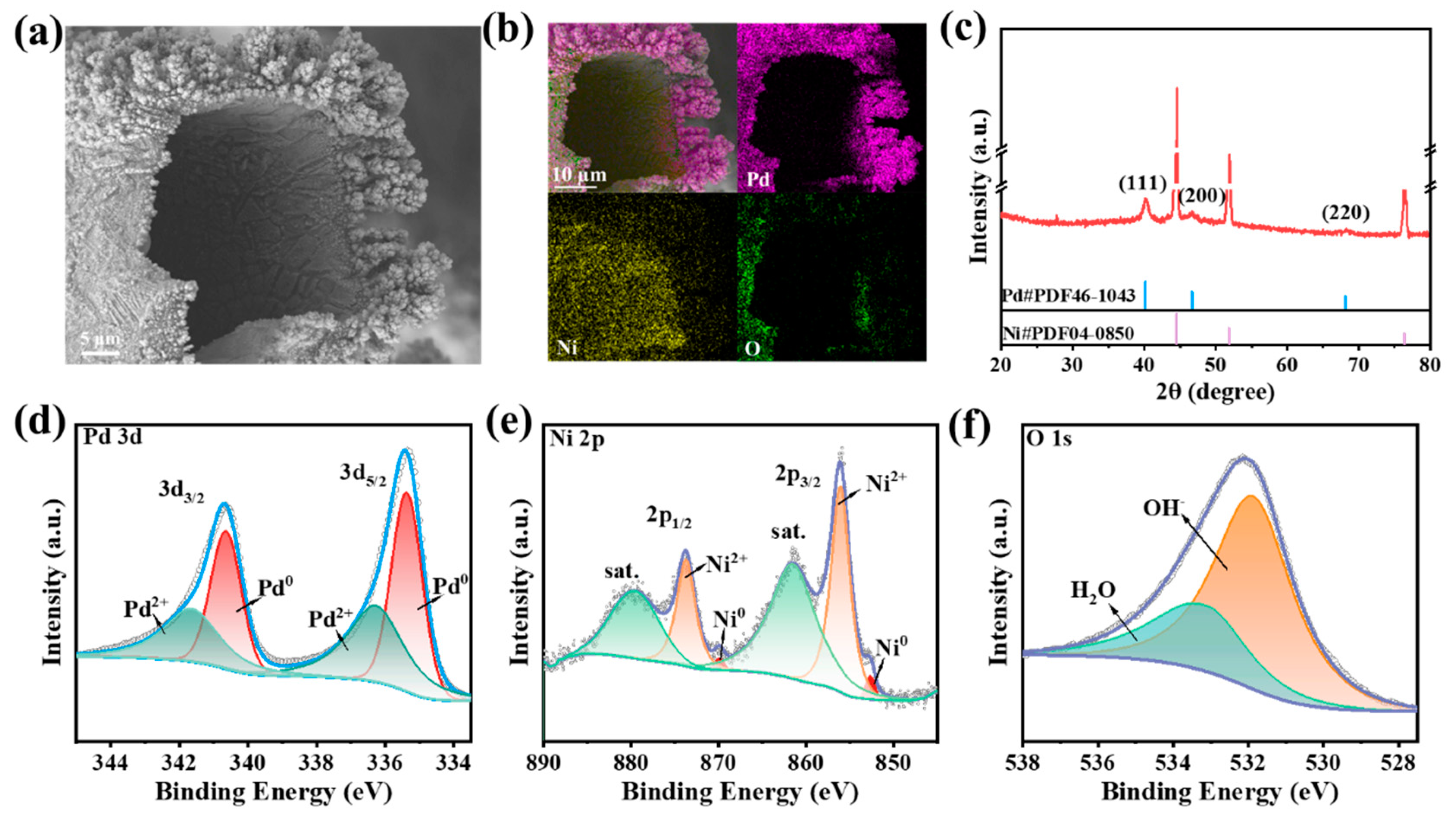
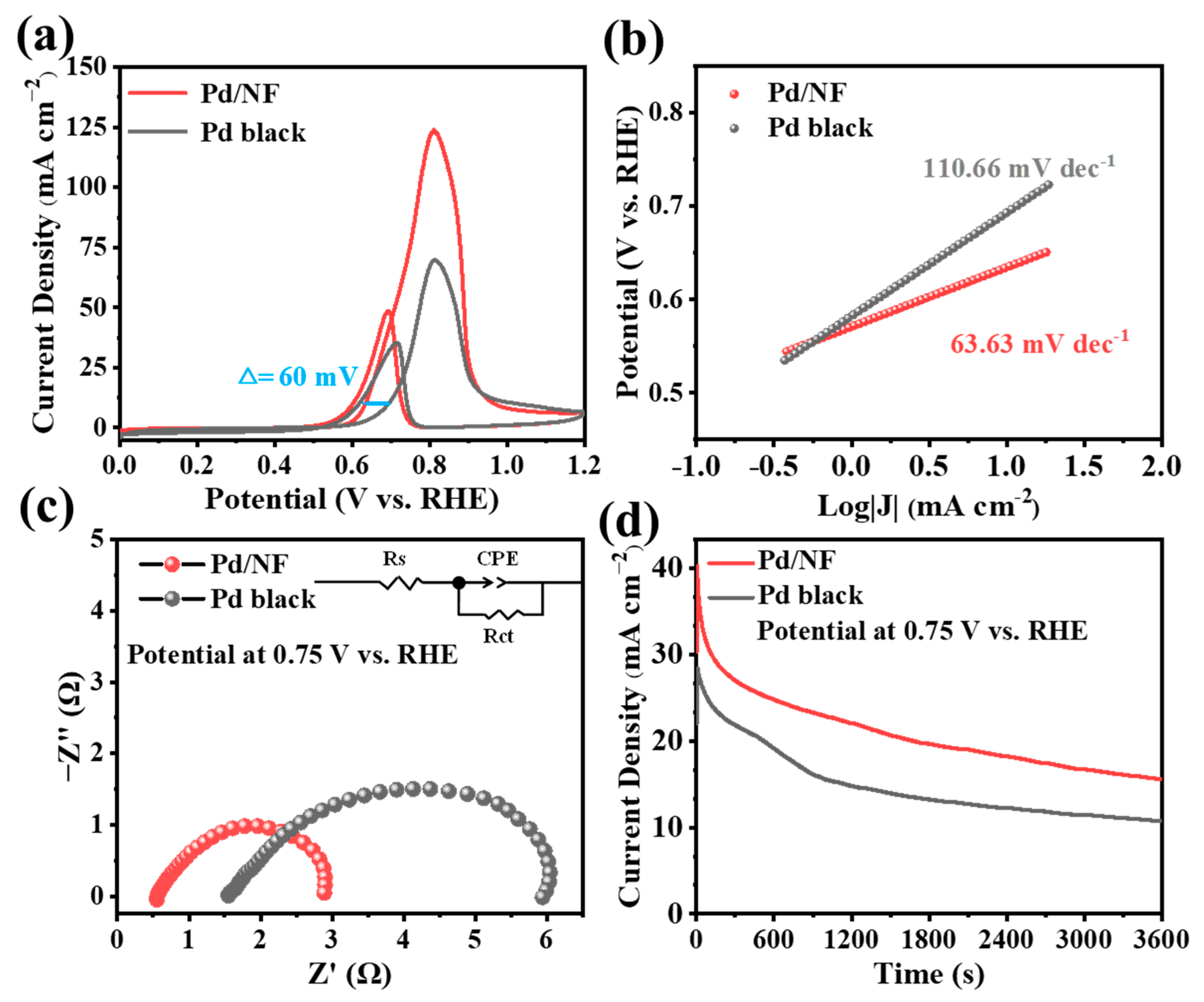
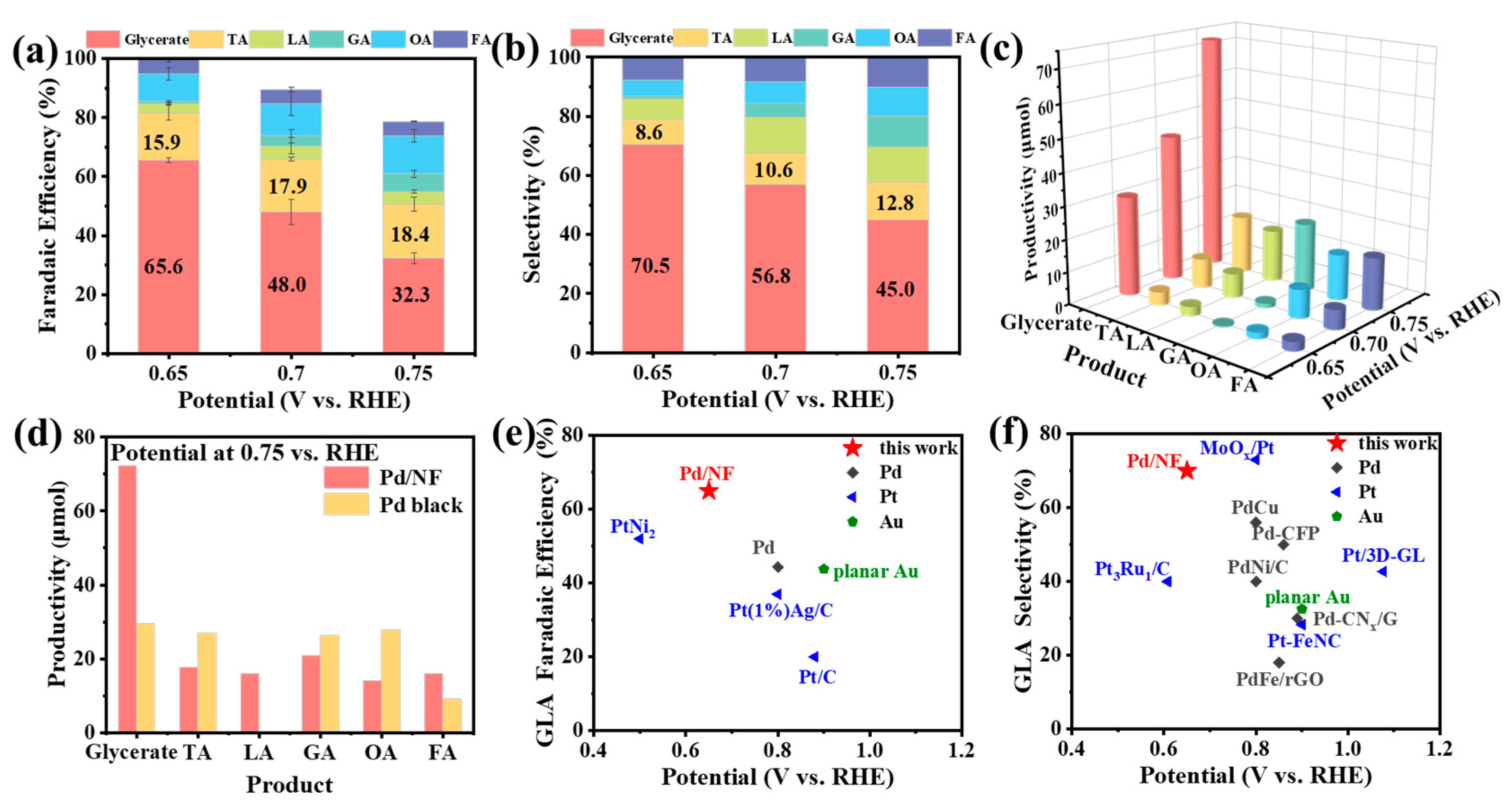

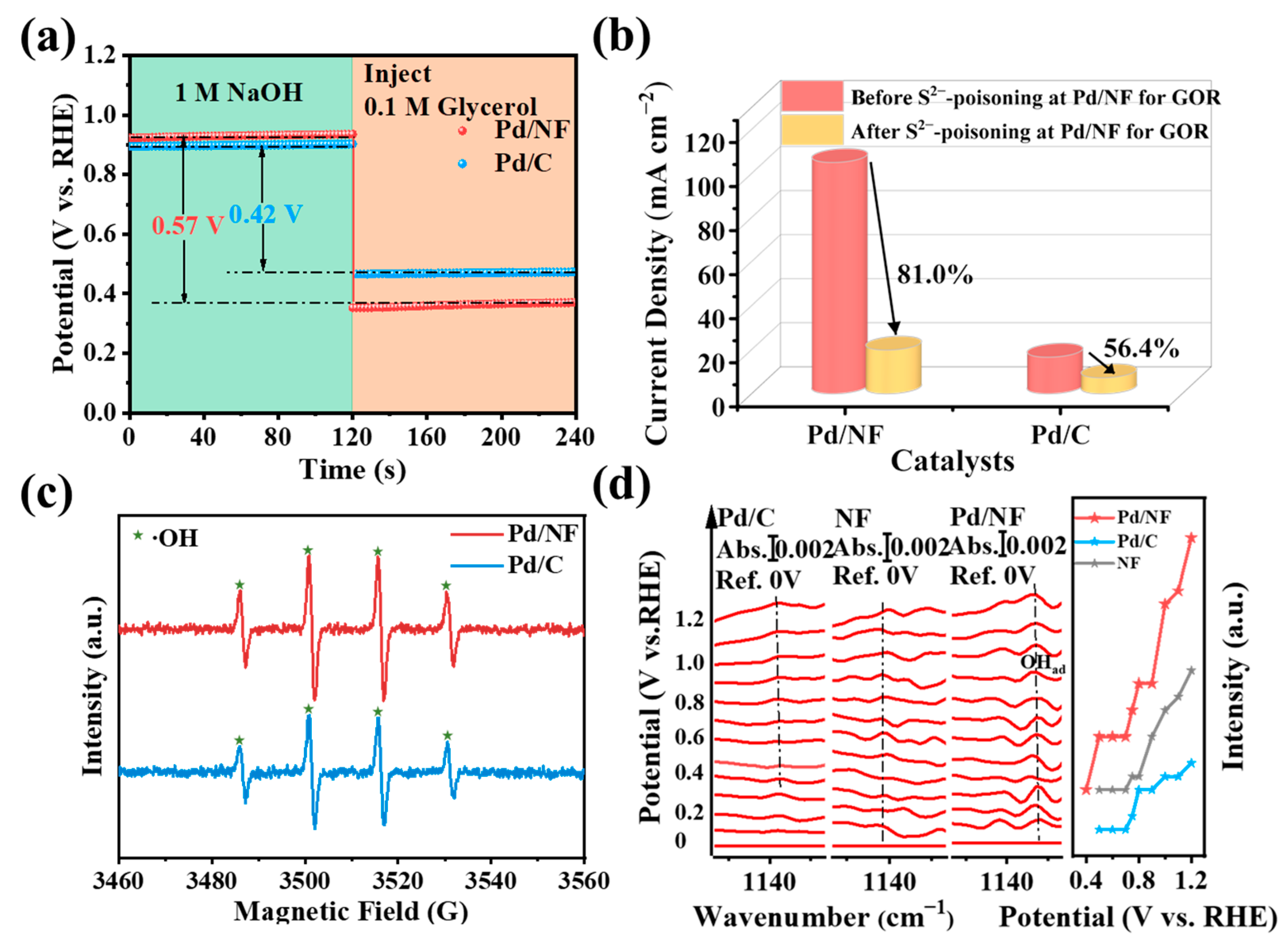
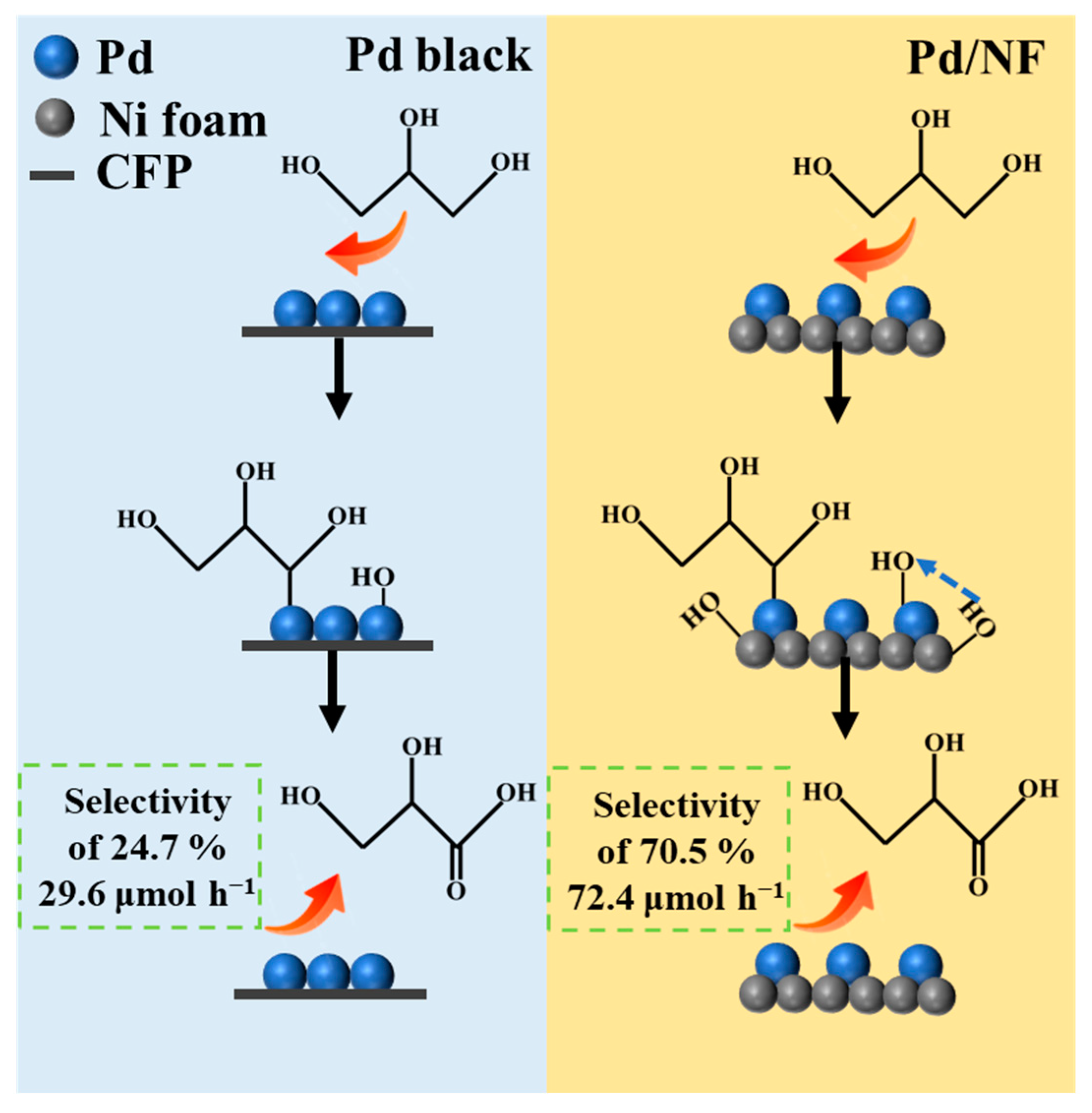
Disclaimer/Publisher’s Note: The statements, opinions and data contained in all publications are solely those of the individual author(s) and contributor(s) and not of MDPI and/or the editor(s). MDPI and/or the editor(s) disclaim responsibility for any injury to people or property resulting from any ideas, methods, instructions or products referred to in the content. |
© 2024 by the authors. Licensee MDPI, Basel, Switzerland. This article is an open access article distributed under the terms and conditions of the Creative Commons Attribution (CC BY) license (https://creativecommons.org/licenses/by/4.0/).
Share and Cite
Zhang, Y.; Wang, L.; Pan, S.; Zhou, L.; Zhang, M.; Yang, Y.; Cai, W. Improving the Electrochemical Glycerol-to-Glycerate Conversion at Pd Sites via the Interfacial Hydroxyl Immigrated from Ni Sites. Molecules 2024, 29, 3890. https://doi.org/10.3390/molecules29163890
Zhang Y, Wang L, Pan S, Zhou L, Zhang M, Yang Y, Cai W. Improving the Electrochemical Glycerol-to-Glycerate Conversion at Pd Sites via the Interfacial Hydroxyl Immigrated from Ni Sites. Molecules. 2024; 29(16):3890. https://doi.org/10.3390/molecules29163890
Chicago/Turabian StyleZhang, Yang, Lin Wang, Shengmin Pan, Lin Zhou, Man Zhang, Yaoyue Yang, and Wenbin Cai. 2024. "Improving the Electrochemical Glycerol-to-Glycerate Conversion at Pd Sites via the Interfacial Hydroxyl Immigrated from Ni Sites" Molecules 29, no. 16: 3890. https://doi.org/10.3390/molecules29163890





